Garden 2024, Early July Edition
Mid-season decisions loom, with the garden "trading deadline" approaching
Editor’s Note: Substack is telling me that this post is too long for some E-Mail systems. If you received this via E-Mail and want to read the whole thing, you can click here to open in a browser.
I thought I would follow up on my gardening post from a couple weeks ago. A couple weeks is an eternity at this stage of the season, with plants growing like crazy, insect activity exploding, and an early summer heat wave complicating things. Injuring my back last week didn’t help. Fortunately, I recovered quickly, thanks in part to my favorite chiropractor. Thanks Russ.
This is a three-part post. So let’s dive right in.
I’ll begin with a couple sad notes. In my last post I mentioned that I was concerned with a possible outbreak of squash bugs on my zucchini. That proved to be prophetic, unfortunately. Here’s what the plants looked like a few days after that post:
Ugh.
When the plants get to this state, it’s time to pull them, which I did. Fortunately, I have a couple other zucchini plants in a separate bed, which still look fine. And I started some new seeds today, which should ensure a supply of summer squash late into the growing season. It’s nice to have some zucchini around for the height of tomato season.
Despite appearances, I don’t think the culprit was vine borers (which are not the same as squash bugs). For those who don’t geek out on summer squash maladies (weirdly, such people exist…), squash bugs look like stink bugs. They just suck the life out of the plants. Vine borers, on the other hand, are the larvae of a moth, which looks more like a large red fly. The larvae embed themselves in the stem of the plant and eventually block the flow of moisture, at which point the entire plant dies within a few hours. It’s as spectacular as it is depressing. Anyway, it was disappointing to see the squash bugs appear so quickly and fiercely. The various creepy crawlies in my magic compost typically restrain outbreaks like this. But not this time. Experienced gardeners develop a sixth sense about knowing when to cut your losses. But the handwriting on this wall was in all caps, and the decision was not difficult.
I needed to make a more difficult — but equally sad — decision on the Brussels sprouts. Here’s what they looked like a couple weeks ago:
Seems okay at a glance. But as I wrote then, my confidence was waning. Various bugs were beginning to eat at the tops, but, more importantly, it just seemed like the plants had reached their fully mature state — which made sense, given that I started them waaaaay back in February. But they weren’t producing anything, even after all that time. Sure, there were a few early signs of sprouting buds on a few plants, but they didn’t progress. So today I finally had to declare this particular experiment a failure, and accept that the space would be best used for something else. It might be worth trying a fall crop, so that the plants can mature into the cooler days that they prefer, but I don’t know if I will have the space. Either way, I made the executive decision to repurpose this space for the second half of the growing season.
So that’s the bad news from my garden. Like a baseball player in a hitting slump, you just have to shake it off and keep swinging the bat. Speaking of sports metaphors, I have a better one for the theme of Part II of this post: the trading deadline.
For you folks who don’t follow professional sports, most leagues set a deadline during the regular season that marks the end of teams’ ability to make trades. Mid-season trades allow teams to position themselves either for the playoffs, or for rebuilding the team in future years, or, sometimes, just to shed some salary. A lot of strategy can be involved. Gardeners face similar choices mid season. Successful gardens are succession affairs. With only a few exceptions, most garden plants do not last an entire season. So if you want a full season of production of, say, lettuce, you need to plan on sowing at least a few rounds of seed at different times. The difficulty of planning this process varies, with the most challenging decision points emerging right about now.
Cucumbers and summer squash are good examples. Both are susceptible to insect damage and disease; it is very common to lose plants mid season. Rather than wage an unwinnable war against these things, I do a succession round of seedlings, so that I have younger plants waiting in the wings if and when the older plants succumb. This can be especially effective because some of the bugs and diseases that plague these plants (like vine borers) are less active to non-existent later in the season. The challenge, of course, is timing. If you start the plants too soon, they might be attacked with their forebearers; if you start them too late, they might not have time to produce before the cold nights of early fall set in.
I find that early July is a good time to sow second rounds of these vegetables, and so I did exactly that today. I did the same for green beans and Swiss chard, the latter being a first for me as a succession crop. I chose to sow a second round of Swiss chard because the first round matured much faster than usual. It is still producing nicely, but I fear that it might be spent as we get into August. Sowing new seed should ensure a supply of nice, tender leaves deep into fall. I also sowed more dill, cilantro and basil seed, even though all of those herbs are still doing well in other parts of the garden. But, again, those first round plants are maturing quickly, and I am not at all confident that they will still be thriving later in the season. In all these cases, I suspect that the plants are benefiting from — but will ultimately be the victim of — early season hot and dry weather, combined with consistent watering. The plants are maturing quickly, but they will also likely peter out earlier. The wise gardener sees these trends and plans accordingly.
I also planted the third (!) round of lettuce today, plus some kale for the fall:
“Wait!” you say. “Hey Tom, what’s the deal with starting the third round of lettuce in a flat? Why not just direct sow?”
Well, I’m glad you asked. So, just to level set a little, only truly crazed lettuce lovers would even think about sowing lettuce seeds on July 7. Every book on gardening will tell you that you can’t grow lettuce in the middle of the summer. I’m here to tell you that this is, uh, kinda true, but not absolutely true. You can sneak in a run of lettuce this time of year, but you have to be smart about it, and you need to adjust your expectations slightly. Mid-season lettuce will not have all of the lively, robust flavors of spring lettuce, and the plants will bolt to seed much faster. But in this gardener’s opinion it is still way worth it.
So what do I mean by “being smart about it”? Well, that’s where the flat comes in. You can beat the system by starting the seeds indoors (typically under lights, but this time of year a sunny window might be good enough). This seems counter-intuitive because you usually start seeds indoors to cheat the early spring cold. But now we’re doing it to cheat the mid-summer heat. Yes indeedy! That’s exactly it. We’re giving the lettuce some time to develop without the stress of the excessive heat and sun. And we will harden off the plants in roughly the same way, when the time comes. When the time finally does come to transplant to the garden, we will provide tons of shade. I use a beach umbrella, but if you prefer to spend money on fancy-pants, garden-specific solutions, go right ahead. Either way, the trick to success at this stage is to provide tons of shade and moisture. If you do this, you can indeed enjoy garden lettuce in late July through mid August.
Incidentally, the kale is more difficult. Most of the same issues apply, but the kale has an additional hurdle, in that young kale plants (and most other brassica family) are extremely susceptible to insect damage this time of year. The trick is to keep them indoors as long as possible, repotting if necessary, and then covering with nets outdoors, until the insect threats subside, typically in late August or early September. If I decide to do fall brussels sprouts, I will need to extend the same courtesy to those, as they are in the same family (yes, kale and Brussels sprouts are closely related).
Incidentally, on the bright side with the kale, if you can get it through this difficult period, it will thrive into the late fall and survive most reasonable winters. And early spring kale that has overwintered is the sweetest and most tender kale you will ever eat. So there’s that.
Moral of the story: If you want a robust garden well into the fall, now is the time to make some decisions — and take action — with respect to succession plans.
On to Part III… I want to share some sights from the current garden, and highlight a few unsung heroes from the first half of the season …surprise picks for the All Star Game.
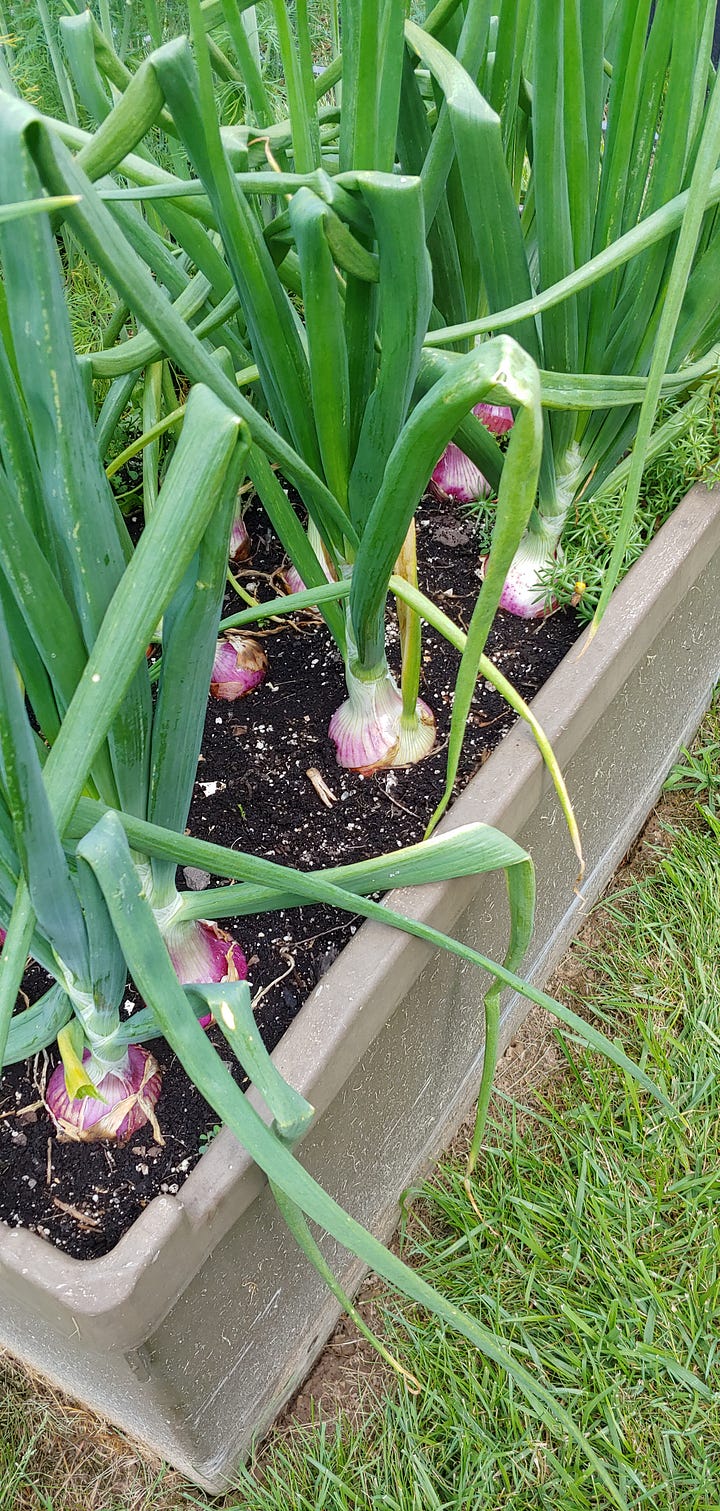
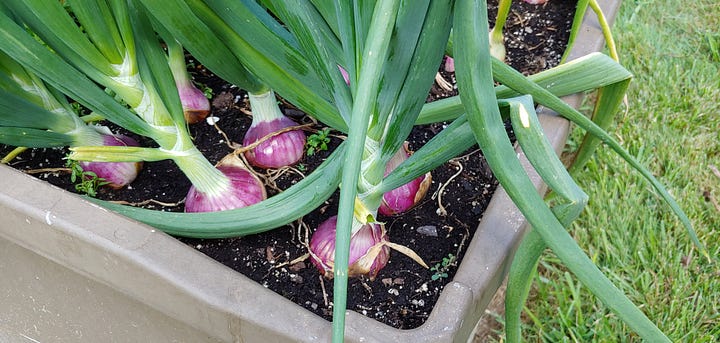
So my onion seeding did not go well this spring. Few if any of my Walla Walla seeds germinated. I finally gave up and decided to allocate the garden space to other things. But I also sowed some Red Amposta seeds, which were a couple years old. Surprisingly, many of those grew. And now they are thriving. I’m not sure I’ve ever grown onions that look this consistently nice. So, yeah, these guys definitely make the All Star team this year.
Here is my cucumber box — actually half cucumbers & half haricot vers beans, but let’s talk about the cucumbers. I realized fairly late that I had no cucumber seeds in my inventory. Desperate, I stopped at the grocery store and picked up a packet of the venerable standard variety of cucumber growers for many decades, none other than “Straight Eight”. I haven’t grown these in decades, so we’ll just have to see how it goes.
You’ll note the trellis, which is one of my classic Rube Goldberg, “use what is available” contraptions. It consists of some old bamboo poles and some netting that I saved from a Christmas tree a few years ago. Again, we’ll just have to see how it goes. I will build a stronger trellis for the second round, as I discovered a roll of welded wire fence that I had forgotten about.
And here are the beans, which I planted on the other side of the box. As I’ve written, beans were a bit of a second thought this year, when I realized that my dog would miss them. All is well so far — we have begun to harvest. Hazel is very happy. Even a tiny 1’x3’ patch of green beans will produce everything you need for eating them fresh, including the dog’s needs (preserving them is another story, but I don’t bother preserving green beans anymore).
The peppers are doing great this year, in part due to the very hot and sunny weather. Here’s one of my favorite varieties, which I propagate from saved seed every year. Havasu is a versatile, mildly hot pepper from the southwest. Just enough heat to add some zing, without burning your mouth. Like jalapenos, you can pick them at any stage of ripeness. These will slowly ripen to a dull orange. As you can see, the plants are very prolific, providing lots of fruit for pickling. This is just the first wave on this plant — there will be many more.
Here is the first round of dill that I mentioned, which, as you can see, is beginning to go to seed. That’s fine — I’ll save those. But this is why I planted the second round of seeds. For now, the bees died and went to heaven — they love the stuff.
And here is the first round of Swiss chard. It’s still producing, but, as I mentioned earlier, I’m doing a succession planting this season because my spidey sense is telling me that this stuff isn’t in the race for the long haul. There’s some parsley and basil on the right side. I didn’t do a second round of the parsley because I deemed it unnecessary. But I did sow a second round of basil.
Speaking of basil, here’s a cute little plant that self-seeded from last season. I didn’t have the heart to remove it. It will soon be sharing its digs with the third round of lettuce.
Here’s a shot of my raised bed, where I am growing tomatoes and winter squash this season, plus a couple extra zucchini plants (which, as we saw earlier, ended up being needed). Everything is cruising along peachily. Ideally, I’d like to build a structure for the winter squash to grow vertically, but I don’t know if I will find the time.
Finally, a couple fun things…
Here’s my latest Dawn redwood sapling. I grow these as a hobby, giving some away and occasionally selling the larger, nicer specimens. This one is in the latter category. I will probably sell it next spring. Sniff sniff… I love these trees.
And here are some groovy cut zinnias, to brighten your day…
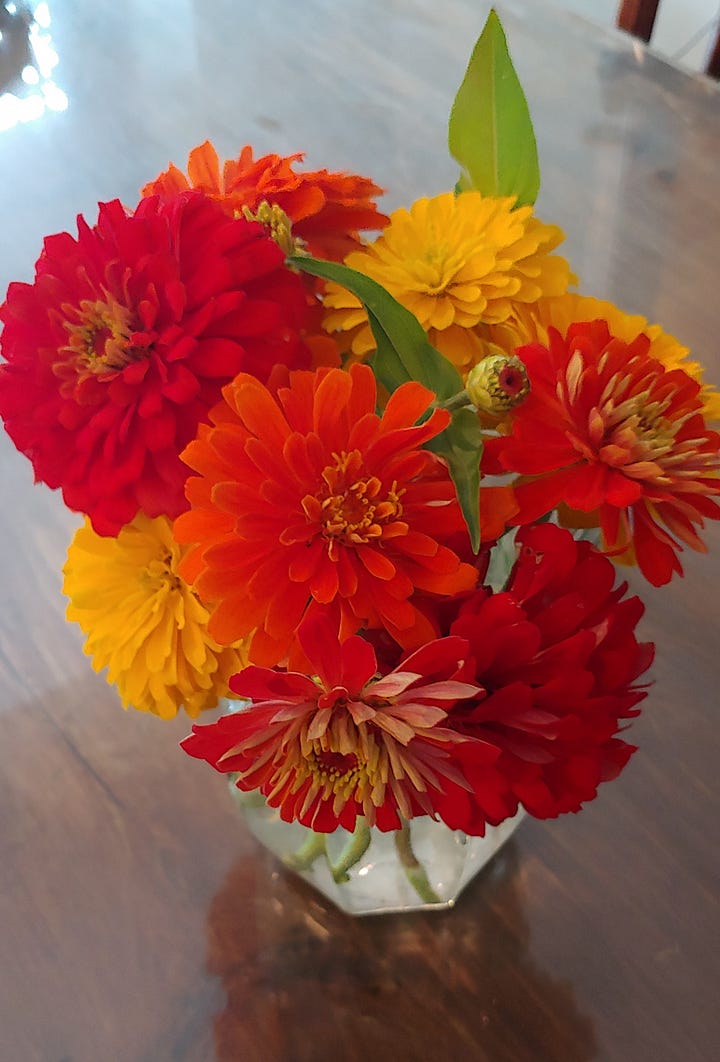
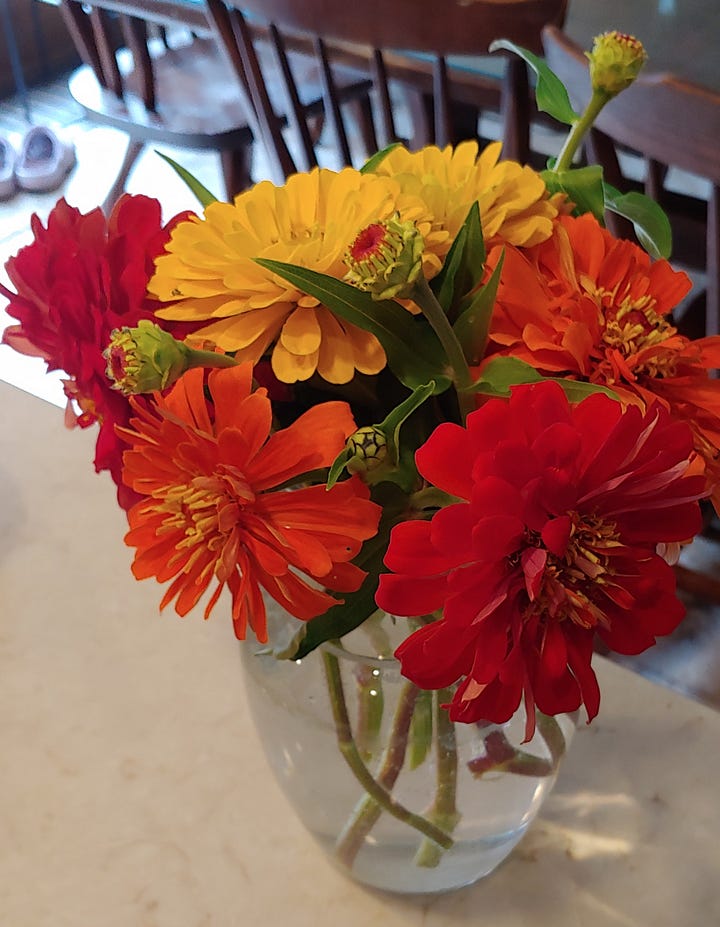
That’s all for today. I will check in again soon, perhaps when all those succession seeds being to germinate…. Have a great day & happy gardening.
PS: The next chapter of my online book will be in your mailbox later this week.





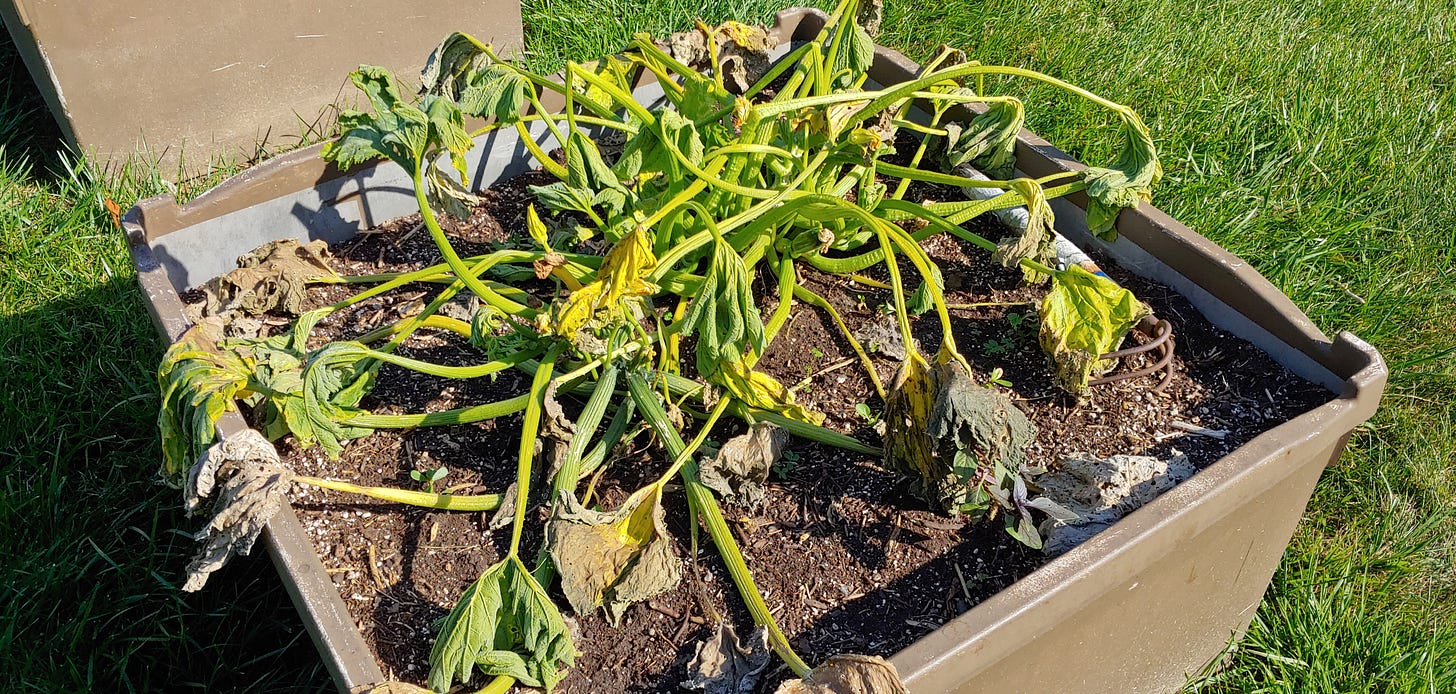





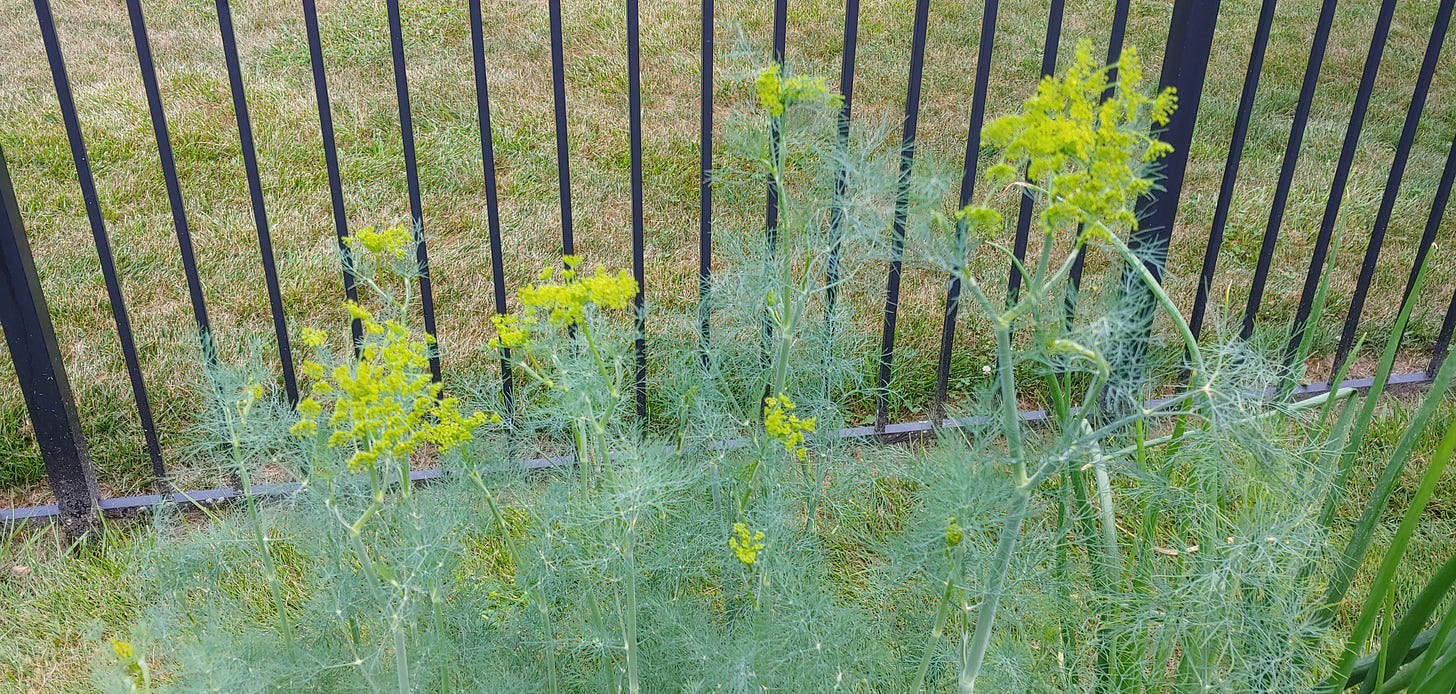


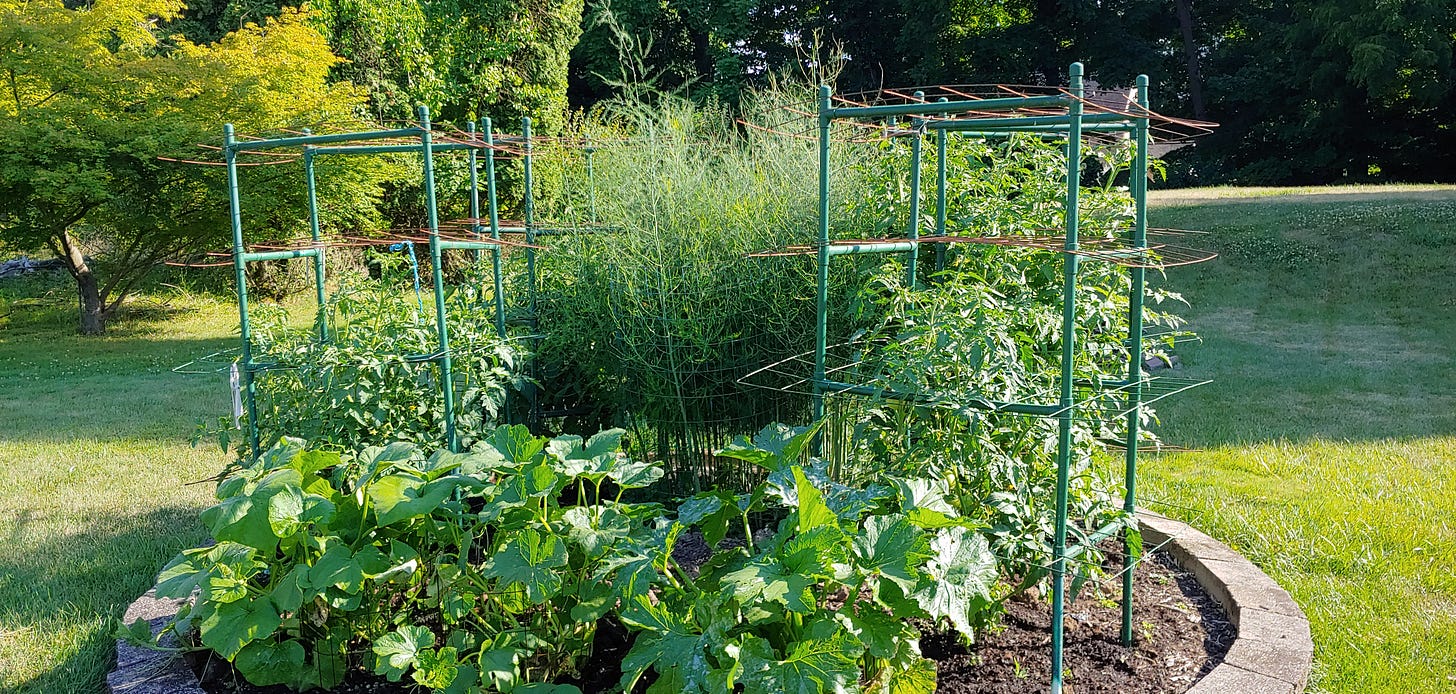

Love that cute little redwood, the zinnias are nice too!